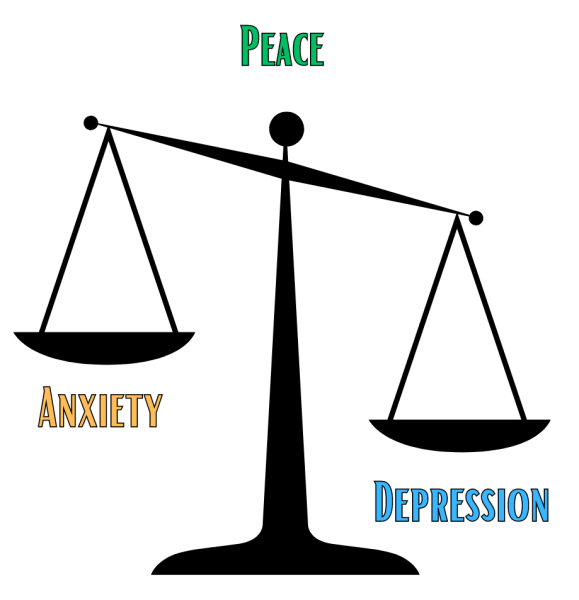Since the COVID-19 pandemic, the youth’s mental health has been steadily deteriorating at an alarming rate. According to Angela Chiu, Ph.D, assistant professor of psychology at the Weill Cornell Medicine institute, “there has been a two-fold increase in the prevalence of clinically significant depression and anxiety among adolescents after the COVID-19 outbreak.”
As a result, our quality of life has worsened as well. In a national survey from the ‘Health Psychology Research’ journal from the National Library of Medicine, 84% of youths from ages 16-24 reported that anxiety negatively impacts their day-to-day life. There’s dozens of factors as to why this is happening; namely, social media, college culture and the pandemic. However, amidst the many debates over the causes of the decline in mental health, the essential concern remains the same: How do we solve this?

As a senior who’s soon to graduate from high school, having experienced the burnout, stress and anxiety of being a junior, sophomore and freshman, the one thing that has sustained me through all of this was meditating. I’m lucky to have been practicing Sahaja Yoga meditation since my early childhood, due to which, I’ve been able to experience, firsthand, how the practice of Sahaja Yoga meditation can improve and strengthen mental health. Sahaja Yoga not only enables us to achieve inner peace, but, overall, empowers us to lead healthy, balanced and fulfilling lives.
Sahaja Yoga meditation is a unique meditation in the fact that it allows us to achieve complete silence within ourselves. When we meditate, all the thoughts in our mind gradually slow down, till our mind is completely silent. This is known as thoughtless awareness because it is a state in which we are aware of our surroundings, but are not reacting or thinking about it. This calming, peaceful state can last from a few seconds to even multiple hours.
Believe it or not, meditation is the key to living in the present. In the human mind, our thoughts constantly shift, in a seemingly endless loop. If we aren’t pondering over our past actions, we are most likely worrying about our future. What am I going to eat for dinner? What if I never said so-and-so? My essay is due tomorrow! — with all these worries in our mind, our attention is so occupied by our thoughts to the point that we are unable to truly enjoy what’s right in front of us: the present moment.

Our thoughts form the basis for mental struggles such as anxiety and depression. Anxiety stems from worries and anxious thoughts about the future. Depression, on the other hand, stems from depressive thoughts about
the past. Our mind continually shifts from the past to the future and vice versa like an imbalanced scale, never coming into the center.
However, between two thoughts, there is a small gap where there is complete silence. When we enter into this silence (a.k.a thoughtless awareness), we are in the present. In this moment, where there are no thoughts (so our attention isn’t on the past or the future), we can truly observe, enjoy, and be a part of the present moment. The past no longer exists, and the future is yet to exist; what’s real is the present. So, although our mind tends to draw us away from the beauty of reality, meditating actually enables us to go beyond our mind so we can embrace what’s real and enjoy it.

The joy of living in the present moment is not only present during our meditation sessions but much after that as well. After a calming morning meditation, I find myself rejuvenated and full of energy to start my day. I go about my day balanced and calm yet positive and energetic. On the other hand, I often feel rushed, stressed and dull when I miss out on my morning meditations. I come home from school much more drained and mentally exhausted.
It’s no surprise that Sahaja Yoga meditation has been scientifically proven to have a positive effect on our brain. A reduced or lower Gray Matter Volume in our brain is intrinsically associated/correlated with worsening anxiety, stress and depression. A 2016 research study on the effect of Sahaja Yoga meditation on the brain found that, compared with people who don’t practice meditation, long-term Sahaja Yoga practitioners had a significantly larger Gray Matter Volume (GMV) across their entire brains.
Suffice to say that Sahaja Yoga has undoubtedly helped me throughout my life and has done the same for many others. Currently, Sahaja Yoga meditation is practiced by thousands of people in over 100 countries since it was founded in 1970 by humanitarian and spiritual leader, Shri Mataji Nirmala Devi.
Shri Mataji had a unique yet powerful vision for Sahaja Yoga. She believed that all humans were capable of experiencing thoughtless awareness. All of us have the internal mechanism within ourselves that allows us to reach the vast expanse of silence and peace. However, most people were unaware of this and were often taken advantage of by people who falsely promised peace and spiritual prowess in exchange for money.

Shri Mataji herself had the innate gift to help others to achieve thoughtless awareness and, so She traveled all around the world, teaching people how to meditate irrespective of socio-economic standing, race, and nationalities — as She believed these were all labels merely created by our mind.
What was most remarkable about Shri Mataji was Her immense love. She selflessly dedicated Her life to spreading this peace and love and empowering people to sustain it through the regular practice of meditation. She never asked for anything in return, and, in fact, insisted on the fact that Sahaja Yoga must be taught for free since, according to Her “Truth cannot be sold; it cannot be purchased.” Instead, She desired that once someone achieves inner peace and learns how to meditate, they can pass this priceless knowledge to others, until everyone has found peace. It’s a global transformation through an inner, spiritual transformation.
In my life, Sahaja Yoga has not only allowed me to feel calm and happy, but it has given me life-long self confidence, balance, and peace— the importance of which can barely be overstated. Although meditating may seem as simple as self-care and we can definitely grow, improve, and take care of ourselves by meditating daily — it can be the key to achieving peace in the whole world. Best said by Shri Mataji, “There can be no peace in the world until there is peace within.”








